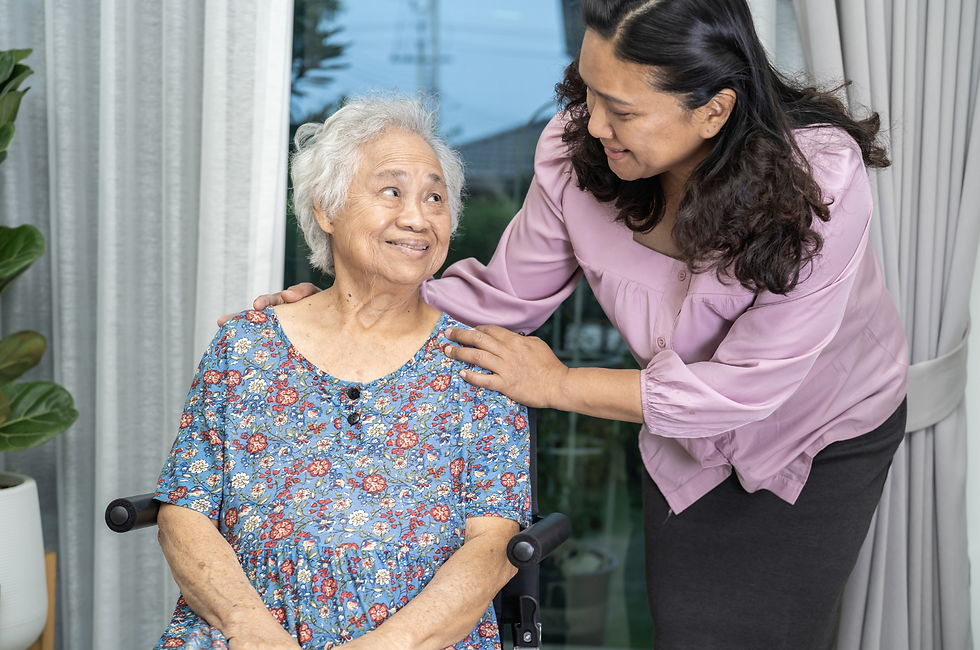Physical Activity and Exercise for Seniors
- Senior Support Services

- Jul 19, 2023
- 4 min read

As we age, staying physically active is increasingly important for maintaining health. Regular physical activity and exercise offer a wide range of physical, mental, and emotional benefits, from reducing the risk of chronic diseases to improving cognitive function and boosting mood. So, what safe, effective, and fun activities can seniors engage in? Read more to find out!
Physical Activity versus Exercise
Physical activity encompasses any bodily movement that results in energy expenditure. This includes walking, exercising, playing sports, or other daily activities that require any degree of exertion. Physical fitness isn’t always the primary goal: for example, you might walk because you need to go to the grocery store.
Exercise is a type of physical activity that is planned, structured, and repetitive with the explicit goal of maintaining physical fitness.
The Physical Benefits of Physical Activity
As life expectancy continues to increase, it is important to ensure that extra years of life don’t compromise health and quality of life. Physical activity is well-established to protect against noncommunicable diseases, including cardiovascular disease, stroke, diabetes, and some cancers. Furthermore, physical activity also decreases the occurrence of noncommunicable disease risk factors, such as hypertension, overweight, and obesity. Being more physically fit improves strength and flexibility, which decreases the risk of falls.
Physical activity also boosts our immune systems, which can protect against harmful communicable diseases commonly found in healthcare or long-term care settings.
The Mental and Social Benefits of Exercise
The benefits of exercise go beyond physical abilities, positively impacting our mental health. Exercise produces endorphins, which are hormones that relieve stress and help us feel good. Exercise can also improve sleep quality and duration, which is especially beneficial for those who suffer from insomnia or disrupted sleep patterns. Frequent physical activity can also decrease the risk of or delay the onset of dementia.
Furthermore, exercise can often be done with others, which adds a fun, social element to exercise. A strong social network is important for seniors to feel a sense of purpose and avoid feeling lonely. Exercising with others can also be a motivating factor and increase safety. As a result, exercise can feel like more of a fun activity and less like a chore.
Overall, physical activity is associated with improved mental health, quality of life, and well-being.
How Much Exercise Do Seniors Need?
The Public Health Agency of Canada recommends at least 2.5 hours of moderate- (e.g., brisk walking, dancing, gardening) to vigorous-intensity (e.g., jogging, running, fast cycling) aerobic activity each week. Furthermore, muscle and bone strengthening activities targeting major muscle groups at least twice a week will help with posture and balance.
Warming Up and Cooling Down
Warming up before exercise gradually increases heart rate and blood flow, preparing you to engage in physical activity and improving your efficiency of movement. Warm-up activities include fast-paced walking, climbing stairs, jogging on the spot, arm swings, lunges, and squats. While static stretches (where you hold one position for a period of time) are commonly included in warm-ups, dynamic stretches (where you perform a series of motions repeatedly) are much more effective at reducing the risk of injuries.
Cooling down after an exercise gradually decreases heart rate and blood flow, easing you into the process of recovery. This can involve reducing the intensity of the exercise you were performing, such as transitioning from a run into a jog or a jog into a walk. Afterward, you should stretch your main muscle groups to relax tense muscles and reduce post-exercise soreness.
Endurance (Cardio)
Endurance exercises increase your breathing and heart rates. Often, they involve partaking in an activity for an extended period of time. They improve your heart, lung, and circulatory system health. Activities include walking, jogging, dancing, swimming, biking, tennis, basketball, climbing stairs, raking, mowing, and gardening.
Strength
Strength exercises build muscle. Depending on physical ability, not all of these activities will be appropriate for every senior. Strength exercises can include using weights or machines at the gym, using resistance bands, or doing body-weight exercises (e.g., pushups, situps).
Balance
Balance exercises can help prevent falls. These can include standing on one foot, walking heel-to-toe in a straight line, yoga, and tai chi.
Flexibility
Flexibility exercises stretch muscles, increasing one’s range of motion. Exercises include a variety of stretches, yoga, and tai chi.
Safety
If, as a senior, you’re not used to exercising or recently had a medical procedure or diagnosis, it is highly recommended to consult with a medical professional. A medical professional can also recommend exercises that will help you best achieve your goals based on your health. If you’re just starting, begin slowly with exercises that you’re comfortable with to reduce the risk of injury.
Wear loose, comfortable clothing and well-fitting, sturdy shoes. Proper clothing will allow for your full range of movement while improving breathability, allowing you to sweat to cool yourself down. Proper shoes provide good support, absorbing shock from repetitive movements and providing extra stability.
Make sure to drink water before, during, and after you exercise, even if you don’t feel thirsty.
If you exercise outdoors, make sure you’re visible. Consider exercising during the day or in well-illuminated areas and wearing bright or fluorescent clothing. If you can’t exercise in a group, let somebody know where you’re going and how long you’ll be gone.
Muscles or joint soreness the day after exercising is normal and will decrease over time. However, if you are uncomfortably sore, consult with a medical professional.
If, at any point, you exhibit any of the symptoms below, stop immediately and consult with a medical professional.
Chest pain or pressure
Trouble breathing or excessive shortness of breath
Light-headedness or dizziness
Difficulty with balance
Nausea








Comments